Echeveria is a perennial herb that belongs to succulents. In the people it has another name - a stone rose. Green succulent leaves, collected in a dense squat rosette, really resemble a strange flower that can grow even on rocky ground.
Material Content:
Variety of species and varieties of echeveria
Echeveria belongs to the family Crassulaceae. Its homeland is hot Mexico, where in nature the plant can reach quite large sizes. In total, there are about 170 species of these succulents.
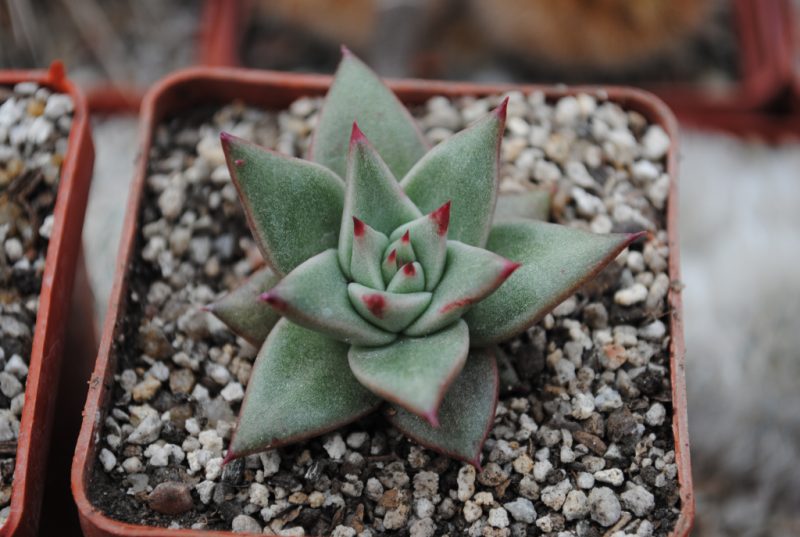
In indoor floriculture, the following types of echeveria are popular:
- Brilliant. A beautiful plant, bright green pointed leaves have a red border around the edge.
- Humpback flower. Young leaves are bright purple, the rest are grayish green.
- Graceful. A plant with green, elongated, rounded, thick leaves, collected in a dense rosette.
- Echeveria Shaw. The leaf plate is not as juicy as in other varieties, has a wavy edge. In appearance, the plant resembles a head of cabbage, most of which leaves fall in winter.
- Black Prince. The species has red-brown leaves, blooms in August and requires bright lighting.
- Echeveria agave. Green-red leaves are pointed at the end. The more light a plant receives, the brighter the red color.
- Lau. The succulent rosette is large, about 20 cm in diameter. The leaves are beautiful, bluish-white, juicy, their length is 6 cm, width 3 cm. Flowers - up to 1.5 cm, orange.
- Crimson. The stem grows up to 70 cm in height, leaves with soft pubescence are not located in the outlet, but on the entire surface of the stem, the lower side and the edges of the leaf plate are red.
- Echeveria Derenberg.It looks like a rounded Christmas tree cones with green leaves instead of scales.
- Pillow-shaped. The leaves are juicy green, velvety, with white hairs. The pubescence of the stem is thick, reddish-brown, the flowers are orange-yellow.
- Miranda. The leaves pointed at the ends can have a different shade - bluish, pink, yellow. In appearance, the plant resembles a lotus flower.
- Echeveria chihuahuenzis. It has a dense rosette of blue-green leaves with a sharp tip, which is painted in red.
- Echeveria purpusorum. Rigid leaves of a triangular shape are collected in a dense basal rosette, have a brownish-green color.
A composition of several types of echeveria with different colors of leaves in one flower pot looks beautiful.
Read also:calathea: home care
Growing Features
Echeveria is grown indoors, because they do not tolerate negative temperatures. In central Russia, these plants are sometimes used in open ground, as annuals, to decorate alpine hills.
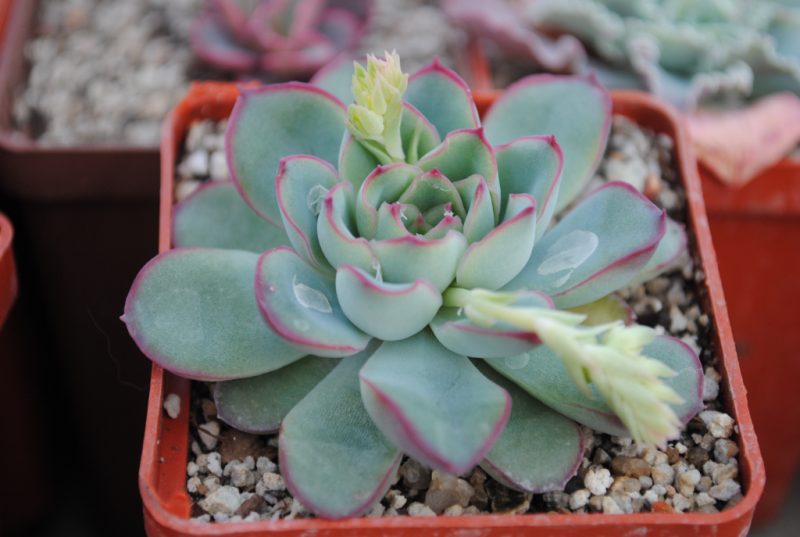
In indoor conditions for eheveri, it is important to create comfortable conditions so that it grows and develops normally.
Planting and replanting a flower
Soil for echeveria is made from peat so that it grows faster. If you need to get a small plant, you can grow it in gravel.
- A drain is placed at the bottom of the pot.
- Baking powder is added to peat for planting - gravel, perlite, vermiculite, sand.
- Echeveria is very fond of bright light, it does not need to be shaded from direct sunlight, but immediately after landing it is taught to bright light gradually.
For transplanting, the soil is suitable for cacti or succulents with the addition of a small amount of coarse sand. For this interesting plant, lower and upper drainage is needed, which can be made from pebbles or sand, the upper drainage should be a centimeter thick.
You can plant interesting compositions from echeveria and other succulents in one flower pot, and decorate them with small stones.
Care for echeveria at home
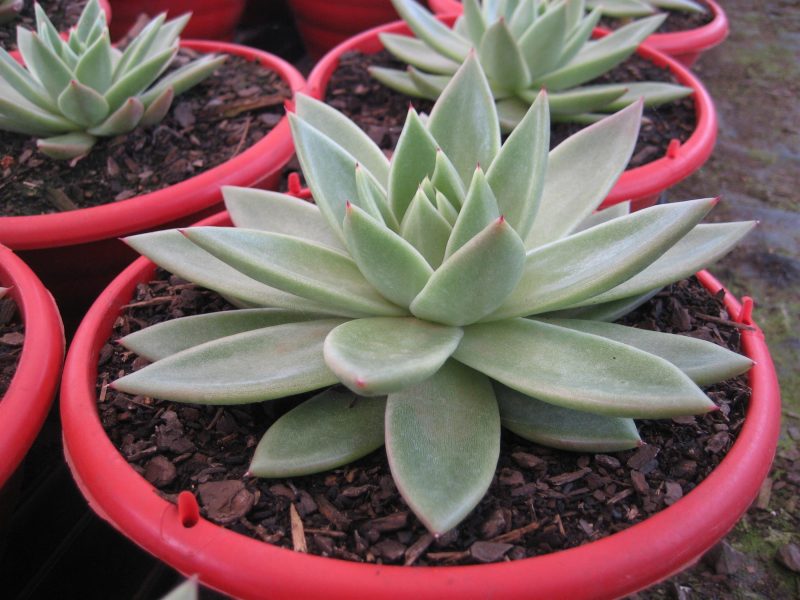
On the leaves of the echeveria there is a protective cover - a waxy grayish-white coating or pubescence. It protects the plant from direct sunlight, so echeveria does not need to be shaded in a hot afternoon on the southern windows. In winter, the plant must be placed on the south or southeast window, where there will be enough sunlight. Without it, the plant will stretch, and lose its attractive compactness. If there is not enough light in winter, you can arrange the backlight.
In the leaves of Echeveria there is a supply of moisture, which allows the plant to do without watering for a long time, but it loves moisture.
- In summer, the plant is watered about 1 time per week, the soil should dry out between waterings 3 cm in depth.
- In winter, you can water it once a month if the room temperature is cool, about + 15 ° C. In a hot room watered as the top layer of soil dries.
Excess water from the pan after watering is drained. Echeveria does not need high humidity and spraying leaves. Species of echeveria with thick white pubescence on the leaves should be watered less often.
They feed the plant with fertilizer for succulents once a month. Feeding begins in early spring, adding them to water for irrigation.
Echeveria has faded - what to do next?
During flowering, the plant throws a high peduncle with brown, yellow or red bell flowers. Echeveria blooms in spring or summer. Flowering does not last long - 2 or 3 weeks.
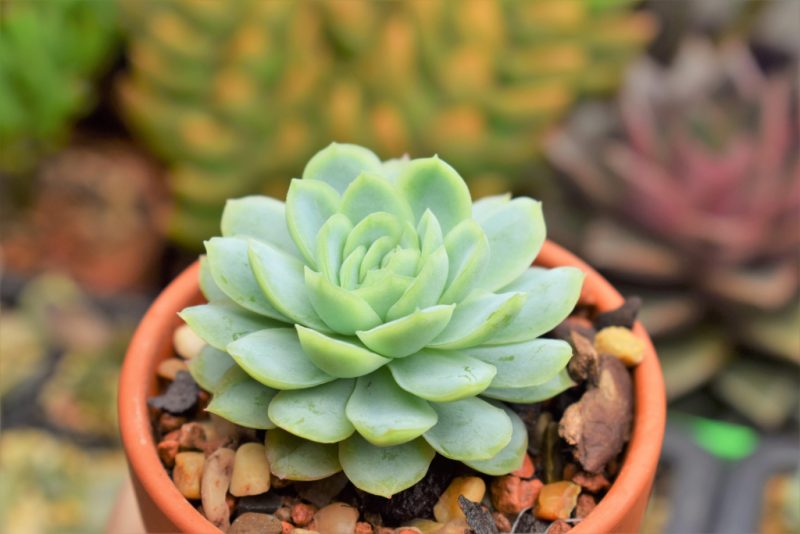
If seeds are not needed, immediately after flowering, the peduncle is cut off - ripening seeds will deplete the strength of the plant. When the echeveria has faded, they surround it with care, feed it with fertilizers for succulents, make sure that it has enough moisture and is light.
Plant propagation
Echeveria can be grown from a leaf in spring or summer.
- The leaf is carefully broken off from the plant, lubricating the place of breakage with charcoal.
- It is dried for several days, and then put on a moistened substrate.
- Soon, a sprout of a new plant with small roots will appear from the base of the leaf.
- After it takes root and grows, it is transplanted into a separate container.
It is difficult to grow a plant from seeds, because they are dusty, very small. They are sown in February in a mixture of earth and sand. Fresh seeds germinate at a temperature of 15 to 20 ° C after 2 weeks. The plant is also propagated by daughter rosettes, rooting in the soil mixture.
Diseases and pests - how to treat?
With excessive watering, the base of the leaf outlet may rot. If yellow or brown spots appear on the leaves - this is a sign of a fungal disease. The affected plant is treated with fungicide. All decayed parts are cut, sections are sprinkled with activated charcoal, and the plant is transplanted into fresh soil.
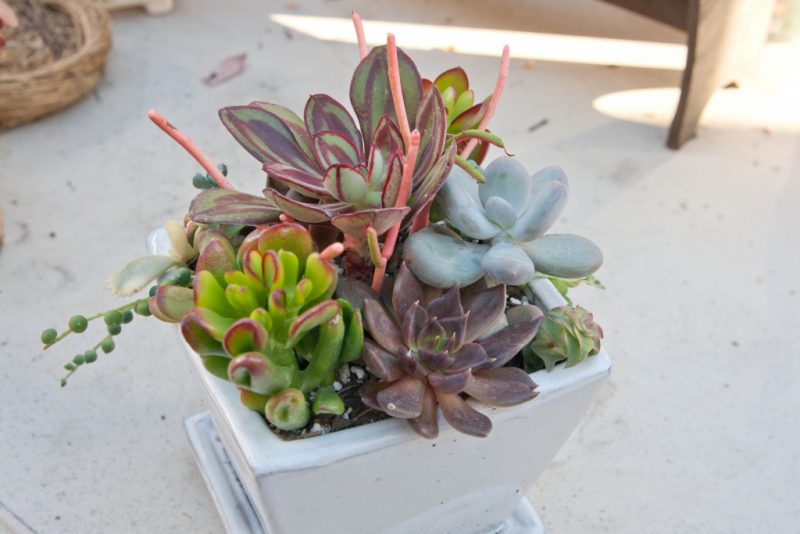
The plant is resistant to pests. Its thick leaves are not so easy to bite through.
Some species of echeveria are affected by the mealybug. Sick plants are sprayed with Fitoverm, Aktellik or Aktoy. Processing is carried out at an air temperature of 22 - 24 ° C. Repeat spraying at intervals of 7 days 2 or 3 times.
Possible growing problems

Growing problems can arise with improper care of the plant:
- with a lack of lighting, the internodes are greatly extended, the trunk between the leaves is exposed;
- the plant can get sick with a fungal disease or simply rot if water gets into the leaf outlet during watering and stays there for a long time;
- from water droplets on the leaves, sunburn may appear if the plant is on the southern windowsill;
- shredding and drying of the leaves can be caused by insufficient watering.
Echeveria flower is an unpretentious plant and, with proper care, you can grow its most exotic species. The plant decorates the room all year round with an unusual kind of leaves, and just like a money tree, it attracts prosperity and prosperity to the house.












